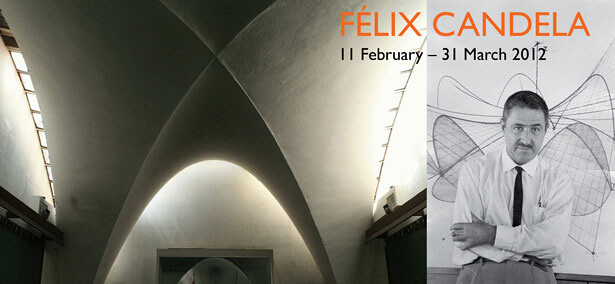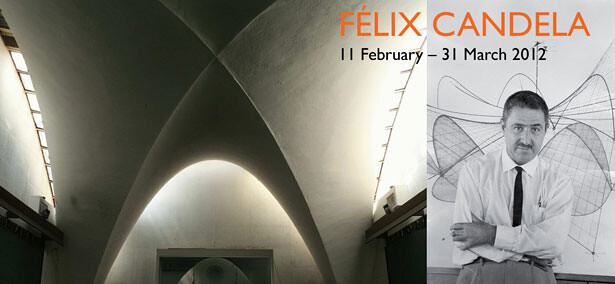11 February – 31 March 2012
Opening Symposium & Reception
Saturday, 11 February 2012
Symposium: 1–6.30pm
Lecture: 6.30–8pm
Miriam and Ira D. Wallach Art Gallery, Columbia University
The Miriam and Ira D. Wallach Art Gallery’s first exhibition of 2012 offers a comprehensive look at the architectural career of “the wizard of concrete shells” — Félix Candela. Regarded as one the greatest Spanish-born architects of the 20th century, Candela is celebrated for his feats of architectural engineering that transformed concrete into visual poetry. Félix Candela, isorganized by Acción Cultural Española (AC/E).
Félix Candela was born in Madrid, Spain in 1910. In 1935 he received his degree in architecture from Madrid Superior Technical School of Architecture. When the Spanish Civil War erupted, Candela enlisted in the Republican Army and served until the republican’s defeat in 1939. Following the war, Candela was exiled from Spain, and sought refuge in Mexico, where, in 1950, he founded his company Cubiertas Ala, translated as Wing Roofs. A year later he executed the Pabellón de Rayos Cósmicos, his first structure utilizing his signature hyperbolic paraboloid geometry. The building began a decade of experimentation with thin-shell construction and the hyperbolic paraboloid form that garnered him international recognition. In 1971, Candela immigrated to the United States and accepted a faculty position at the School of Architecture at the University of Illinois. Candela’s final project, executed posthumously following his death in 1997, was the restaurant at the Valencia Oceanographic Park in Spain.
The exhibition at the Wallach Art Gallery is organized around three periods of Candela’s career and highlights his vast body of work, including the Cosmic Rays Pavilion and his self-identified favorites—Los Manantiales Restaurant, Chapel Lomas de Cuernavaca, Bacardí Rum Factory, and the Church of Our Lady of the Miraculous Medal. For the exhibition, the curators, Juan Ignacia del Cueto Ruiz-Funes and Angustias Freijo, have brought together twenty-one scaled models, a selection of photographs, a documentary film, and videos and animations of Candela’s emblematic work. Together, they offer a comprehensive understanding of the architect’s work and the contexts in which it developed. Notable is a selection of original architectural drawings and renderings from the Drawings and Archives Collection at Columbia’s Avery Architectural and Fine Arts Library.
The exhibition, Félix Candela was originally presented in 2010 at the Institut Valencià d’Art Modern on the occasion of the centenary celebrations of Candela’s birth. It subsequently travelled to the Museo Extermeño de Arte Iberoamericano (MEIAC) of Badajoz, Spain and Museum of Modern Art of México City. The exhibition is organized and circulated by the Acción Cultural Española (AC/E).
Opening Symposium and Reception
11 February, 1–8 pm
An opening keynote address by professor David Billington of Princeton University, co author of Felix Candela: Engineer, Builder and Structural Artist, will introduce the life and work of the architect. Two thematic panels explore Candela’s legacy within architectural and engineering discourses, and the political contexts within which his career developed. Closing remarks by the exhibitions lead curator, Professor Juan Ignacio del Cueto Ruiz-Funes and a celebratory opening reception in the gallery will end the afternoon.
Organized in collaboration with Avery Architectural and Fine Arts Library.
For schedule and program details please visit the the gallery web-site.
About the Wallach Art Gallery
The Miriam and Ira D. Wallach Art Gallery aims to contribute to Columbia’s long-standing tradition of historical, critical and creative engagement in the visual arts. Since its establishment in 1986, the gallery, modeled on a laboratory, has been a forum for exhibitions related to research by graduate students, faculty and other scholars. The programming provides a bridge between the university’s diverse interests and approaches to the arts and a broad public audience.
The Wallach Art Gallery is located on the 8th Floor of Schermerhorn Hall on Columbia’s Morningside Heights campus, 116th Street and Broadway in Manhattan. Gallery hours are Wednesday through Saturday, 1:00 p.m. to 5:00 p.m.


